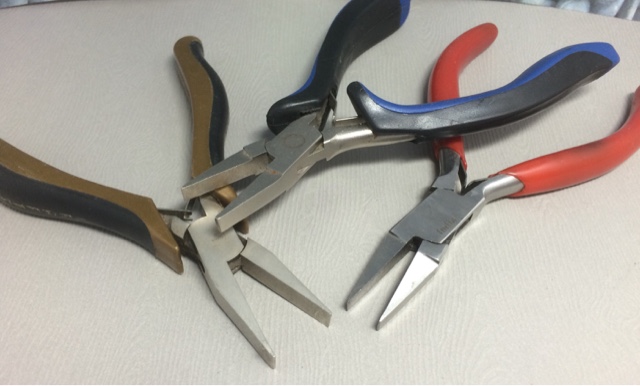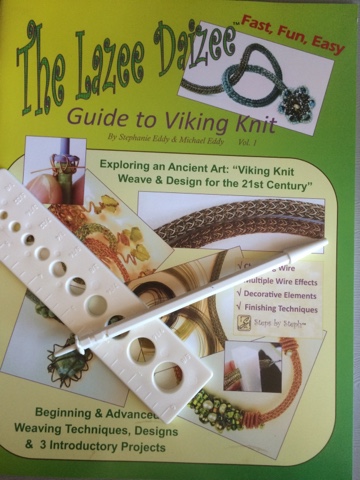A gal asked me if I had any tips on tools, supplies and the like for creating jewelry, and I thought to myself, 'Huh, this would make a great blog topic.'
So before I begin talking about the basic tools for jewelry making, I thought it might be nice to go over the actual anatomy of pliers...
Pliers can be made with differing types of steel along with different types of joints. The most important aspect of the pliers will be the construction: this will tell you the quality of the pliers.
CONSTRUCTION
• Forged is the highest quality you can get. These type of pliers are forged from a rod of tool steel and are work hardened as the metal is compressed and shaped. Then the pliers are tempered to prevent brittleness and produce the best combination of durability and strength.
• Cast: these pliers are formed in a mold made from molten metal and are not tempered.
• Stamped: these type of pliers are made from a sheet of metal; they're the cheapest in both cost and quality.
JOINTS
One half of the pliers joint surrounds the other half, and the pivot is hidden within. This type of joint holds alignment far longer than a lap joint but limits the opening of the jaws.
• Lap:
A lap joint has one half of the pliers joint overlapping the other half, and a pivot or screw is set through both halves.
HANDLES
Did you know that when you grip a pair of pliers, you are using over 40 muscles? That's a lot of muscles at work! It is imperative to get pliers with ergonomic handles so that they conform to the shape of your hand. I'd recommend getting pliers that have either soft plastic or foam handles.
COMPOSITION
High-carbon or high-chrome alloy steel is the highest quality steel that produces the longest-lasting pliers and cutters. Yes, they are priced more significantly than hardened tool steel, but they are worth it! Stainless steel is also of good quality and will have a reasonable life.
Here is a great link that describes pliers to the hilt: http://www.silversupplies.com/catalog/tools/pliers/
O.K. on to the basic tools for jewelry making which are: round and flat nose pliers plus flush cutters; optional are bent chain nose pliers. Then we have rulers, tape measures, Sharpies, and more.
3-in-1 or 4-in-1
If you are just starting out and want to save some money for supplies, or you are unsure of the type of jewelry you will make, or this is a hobby - BUY yourself some 3-in-1 or 4-in-1 pliers. These are inexpensive and will last awhile. I bought a pair of 4-in-1 pliers which are round/flat nose, cutters and have a groove to close jump rings.
These pliers lasted me years, and I still keep them around just in case.
ROUND NOSE PLIERS
Round nose pliers have tapered jaws from pivot to tips. These are used to make various loops, S-hooks, jump rings, clasps, coils/spirals and curved bends, plus to form headpins and eyepins.
You will use this type of pliers the most, and despite what other sites say - I'd highly recommend buying the highest quality you can afford. I bought cheapie round nose pliers (according to so many people's recommendations.) Let me tell you - the cheap ones' tips dont match up, and this makes it extremely frustrating!
There are standard and long round nose pliers that you can get. The standard ones, you will use on a regular basis. The long round nose pliers are used to make coils. The longer the jaws on any type of pliers, the less control you have.
High-quality pliers to look for: Swanson (Rio Grande), Lindstrom, Wibbers, OHM and Euro Tool.
FLAT NOSE PLIERS
Flat nose pliers have a flat interior surface inside the jaws and are used to hold components, open/close jump rings, make angular bends in wire and also to straighten and strengthen wire. Plus with flat nose pliers you can make spirals and close crimp covers. These also come in standard and long as well as narrow and wide. I have several types and use them for different applications.
CHAIN NOSE PLUERS
If you will be doing a lot of chain mail work, you should definitely invest in straight chain nose vs. bent chain nose pliers.
With chain nose pliers, both jaws are semi-round with flat interior surfaces and taper at the end. They are used for holding components, opening and closing jump rings, and reaching into tight places. The tips on the bent chain nose pliers are angled, and these are perfect for holding wire when you wrap so you can see what you are doing.
I didn't buy bent chain nose pliers for a long time because I never really used the straight ones for anything. After I bought a pair of these, I cannot even fathom wire wrapping without them!
CUTTERS
The ones on the bottom are Lindstrom that were destroyed because I cut memory wire with them. The red handled flush cutters are from Ace Hardware and are of good quality. The cutters with the royal blue handles cut up to 14ga wire and metal.
Oh the joy of cutting! There are several types of cutters out there - definitely buy the highest quality you can afford! AND do NOT use them to cut memory wire!!!! Let me repeat that: DO NOT USE ANY TYPE OF CUTTERS other than Memory Wire Shears to cut memory wire. You will dull the cutters very quickly after one single use of cutting memory wire.
Memory wire is a type of steel wire that retains its shape. You can only use Memory Wire Shears to cut this type of wire!
I have bought so many cheapie cutters over the years because I didn't want to invest $50.00 into a good pair of cutters... and then when I finally broke down and bought a pair of Lindstrom flush cutters - I used them to cut memory wire. Oh my golly gee - what a waste of $$$! I've never been able to use them again! The blades don't match up even though I had the blades sharpened. *sigh*
• FLUSH cutters, also known as SIDE cutters: the jaws are pointed and angled, almost parallel to the handles. If you don't want a bur on the end of your piece of wire, you need to turn the pliers around so that the straight edge is away from the section of wire you are cutting. If you don't want to deal with this bur, buy a pair of super flush cutters.
• END cutters: these type of cutters have blades perpendicular to the handles and provide more cutting leverage. Use these to make sharp, clean cuts close to the surface of wire.
The shears on the left are Memory Wire Shears and the cutters on the right are End Cutters.
• OBLIQUE cutters: a type of end cutters that feature an angled head to allow you to cut hard-to-reach areas. Only use these to cut softer metals.
• COMPOUND cutters: these are designed with two joints to maximize hand power when cutting thicker, heavier metals.
RULERS and TAPE MEASURES
Make sure to have some of these handy. I'd get a metal ruler, a see-through ruler and of course a tape measure. Also look for rulers with standard and metric, preferably going in the same direction. Most rulers have these two but inches are left to right and centimeters is right to left.
I have rulers - metal, see-through, tape measures and a sticky ruler. The latter being on a roll, and I just pull off 12" and stick it to my workbench. I absolutely love this type of ruler!!!
SHARPIES or other PERMANENT MARKERS
I know it seems weird but Sharpies are magnificent tools! You can use them to mark the tips of your round nose pliers so that you can make consistent loops and also use them as a mandrel.
BEAD MAT
This, of course, is optional. A bead mat protects your work surface and also keeps beads and components from sliding around.


























































